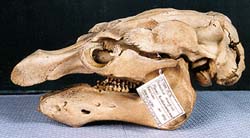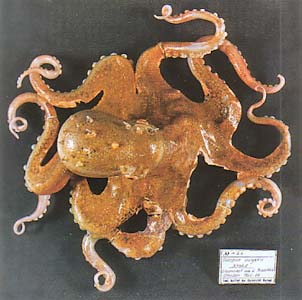Zoological Collection of the University of Rostock (ZSRO)

The Zoological Collection of the University of Rostock (ZSRO) is located on Universitätsplatz, right in the heart of the Hanseatic city. The collection has been in existence for around 250 years, making it one of the university's oldest permanent institutions. In times of ever-decreasing biodiversity, it is important to us not only to research biodiversity and teach students, but also to educate all visitors about our regional and global biodiversity. In addition to research and teaching, we also fulfil the third central task of universities, the transfer of knowledge to society (third mission).
Contact

Contact Address:
Dr. Sören Möller, Institut für Biowissenschaften, Lehrstuhl Allgemeine & Spezielle Zoologie, Universitätsplatz 2, 18055 Rostock, Tel. +49 381/498 6278, Fax 498 6262, e-mail:soeren.moeller(at)uni-rostock.de.
Opening hours: Mo - Fr 10 am - 4 pm
Guided tours (for groups of max. 16 persons) in the historical part of the collection ('Schaumagazin') by appointment with Antje Hlawa (Tel. +49 381 498 6281, antje.hlawa(at)uni-rostock.de).
Public Lectures: See special announcement.
Museum shop: Books, postcards and flyers on special exhibits.
Inventory
Our collection focuses on marine, brackish and freshwater animals, fish, molluscs, birds and insects. Highlights include the famous Rostock Arrow Stork from 1822 (the oldest evidence of long-distance bird migration, which triggered a paradigm shift at the time, cf. Kinzelbach 2005); evidence of the oldest scientific anatomy of an Amazonian manatee (Trichechus inunguis), collected by the Austrian Brazilian researcher NATTERER through H. F. STANNIUS; two ichthyosaurs from Holzmaden (see below); Australian animals from the Rostock-born botanist Baron Sir Dr. Ferdinand VON MUELLER (1825-1896), Melbourne; among others Reptiles and amphibians from America from the LAAGE-born merchant Theodor CORDUA (1796-1857), at times the richest man in America; remains of VON PASSOW's antler collection from Mecklenburg; material from CHUN's deep-sea expedition; the mollusc collection from the Grand Ducal collection with the ‘Linksche Typen’ and a rich collection of freshwater mussels from the Western Palaearctic by R. Kinzelbach is of supra-regional importance. Over the past decade, several former residents of the Rostock Zoo have been added to the collection: Polar bear ‘Churchill’ adorns the entrance area of the house, Rostock's last female elephant ‘Sara’ as a skeleton preparation in the biodiversity room. The new highlight there is the wall of biodiversity, mainly featuring the regional collections of Karl-Heinz GRIESSBACH and Heinz-German FISCHER.
F. E. SCHULZE procured glass models of animals from the world-famous BLASCHKA company and wax models from ZIEGLER. There were also plenty of wall charts by LEUCKART, in the design of which several professors from Rostock were involved. The University of Rostock had a geological and mineralogical collection, which was founded by Bergrat GIESEKE in 1803. It was expanded in particular by the internationally renowned geologist Prof. Dr. Eugen GEINITZ (active 1878-1925), who worked in Rostock around the turn of the century. With the relocation of the geosciences to the University of Greifswald in 1968, Rostock lost this collection.
One special fossil has remained with us. A stone slab with the only vaguely discernible skeleton of an ichthyosaur, a representative of the fish lizards that flourished in the Mesozoic Era, had been lying unnoticed in a dusty box in the University's Zoological Collection for as long as anyone could remember. It comes from the collection left to the ZSRO by PD Dr. A. Ch. SIEMSSEN (1768-1833), the ‘father of Meklenburg's zoology’. The cleaning revealed that it was an original: Rostock's only ‘real’ dinosaur. In addition, Dr. Katharina SPRINGER has given us another magnificent specimen on permanent loan.
Functions
Due to its basic concept of academic teaching, the collection is orientated towards the entire animal kingdom worldwide and is in principle not a regional collection. Different functions come together:
• Research collection with specimens from all over the world for new descriptions of species (type material) and scientific publications.
• Teaching collection for students (species knowledge, anatomy, histology, material science).
• Display collection for the public (schools, groups, natural history museum in the ‘’cultural mile‘’ of Rostock).
• Collection of specimens and comparative samples for Mecklenburg-Vorpommern and the Baltic Sea.
• Working collection for faunistics, nature conservation and nature management.
Today, the collection is being expanded in line with current in-house research, especially birds and fish among the vertebrates, crustaceans, bristle worms, molluscs and other marine animals among the invertebrates. The historical material is prepared and made available for biodiversity research, currently the internationally significant stocks of molluscs and scorpions. The collection is thus an integral part of general and systematic zoology. The display effect, which constantly comes to the fore, only affects a small proportion of the objects and is a desirable secondary function. The objective of the scientific collection is multifunctional:
• The original objects from the animal kingdom are made available in suitable preservation (also for the purposes of molecular analysis).
• Provision of all publications on these objects.
• Collection of all biographical data on the collectors, donors and scientists involved.
This makes the collection a part of national cultural history beyond natural history.
Situation and Perspectives
The Zoological Collection is currently extensively integrated into the teaching and research activities of the Department of General and Systematic Zoology and is also open to non-university members on weekdays.
The collection is a member of the Museumsverbund Mecklenburg-Vorpommern and the NORe Museumsverbund. This is an association of natural history museums and natural science collections in the North and Baltic Sea region, which have complementary research expertise and collection data. The museums in the network work on joint research projects and co-operate in collection management and outreach work.
Literature
BICK, A. Die Zoologische Sammlung der Universität Rostock im Wandel der Zeit. Archiv Natur- und Landeskunde Mecklenburg-Vorpommern 58 (2021). pp: 103-130. https://doi.org/10.30819/anlk.58.10
RICHTER, S.; Bick, A. (2018): Chapter 49. Rostock: The Zoological Collection of the University of Rostock. In: L.A. Beck (ed.), Zoological Collections of Germany, Natural History Collections, Springer International Publishing AG 2018, 583-589. https://doi.org/10.1007/978-3-319-44321-8_49
KINZELBACH, R. (2005): Das Buch vom Pfeilstorch. 80 p., Marburg (Basilisken-Presse).
KINZELBACH, R. (2005): Die Zoologie an der Universität Rostock. Zoologie 2004/05, Mitt. der Deutschen Zoologischen Gesellschaft: 33-48, Marburg.
KINZELBACH, R. (2004): Hermann Friedrich Stannius (1808-1883) und die Amazonas-Seekuh in der Zoologischen Sammlung der Universität Rostock. Stier & Greif 13: 70-78, Schwerin.
KINZELBACH, R. (2000): Die Zoologie an der Universität Rostock: Von der Wunderkammer zu Biodiversitätsforschung und Biotechnologie. Eine historische Übersicht. Verhandlungen zur Geschichte und Theorie der Biologie 5: 159-181, Berlin (VWB 2000).
BRAUN, M. (1891): Geschichte der Zoologie und der zoologischen Sammlung an hiesiger Universität. – Arch. d. Freunde d. Naturgesch. in Mecklenburg 44: III-VII, Güstrow.
LINK, H. F. (1806-08): Beschreibung der Naturalien-Sammlung der Universität zu Rostock.


